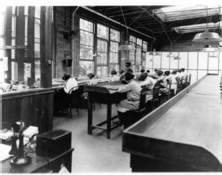They say that if you visit the grave of Katherine Schaub and bring a Geiger counter, the machine will register a significant positive reading. Katherine, a radium dial painter, died in 1933 after suffering for more than a decade from a disease chillingly named radium necrosis.
In 1902, the self-proclaimed American inventor William Hammer returned from Paris with a gift given him by Pierre and Marie Curie: radium salt crystals. Mr. Hammer experimented with various combinations of glue, zinc sulfide, and radium crystals to form an iridescent paint that created a glow-in-the-dark effect and could be applied to just about anything—wristwatches and clocks, gun sights, children’s toys, even human bodies (in the form of fingernail polish).
Hamilton sold his paint to a New Jersey company founded in 1914 by Dr. Sabin Arnold von Sochocky and Dr. George S. Willis. Though they originally called it the Radium Luminous Material Corporation, Sochocky and Willis changed the name to United States Radium Corporation in 1921. They set up shop in Orange, New Jersey, intent on developing a market for their product; they assured the public that the radium was in “such minute quantities that it is absolutely harmless.”
They dubbed the paint-like substance Undark.
*
Grace Fryer, Edna Hussmann, Katherine Schaub, and sisters Quinta McDonald and Albina Larice were five of the over two thousand dial painters employed by U.S. Radium and its attendant companies over the next couple of decades. Their job was straightforward: to paint the dials of watches, clocks, and military instrument panels for use in ships, airplanes, and other equipment that demanded nighttime use.
Most of the time, however, they painted wristwatches.
“I was pleased with the idea of a job which would engage me in war work,” Katherine said. “Some of the young women would scratch their names and addresses into these watches, and sometimes a lonely soldier would respond with a letter.”
The work was tedious, the conditions physically hard on the eyes, back, and hands. They were paid by the piece—one and a half cents per watch—thus some of the women made about twenty dollars per week with U.S. Radium. The median income of New Jersey women workers in 1917 was about fifteen dollars per week; these were good jobs for working women.
The labor was exacting. The numbers and symbols on the dials were often small, thus the camel-hair brushes had to be sharp. To accomplish this, the women were instructed by their managers to lick the ends of the brushes to keep them pointed, ready for the meticulous work. Undark, after all, was tasteless and odorless. “I think I pointed mine with...
You have reached your article limit
Sign up for a digital subscription and continue reading all new issues, plus our entire archives, for just $1.50/month.
Already a subscriber? Sign in





